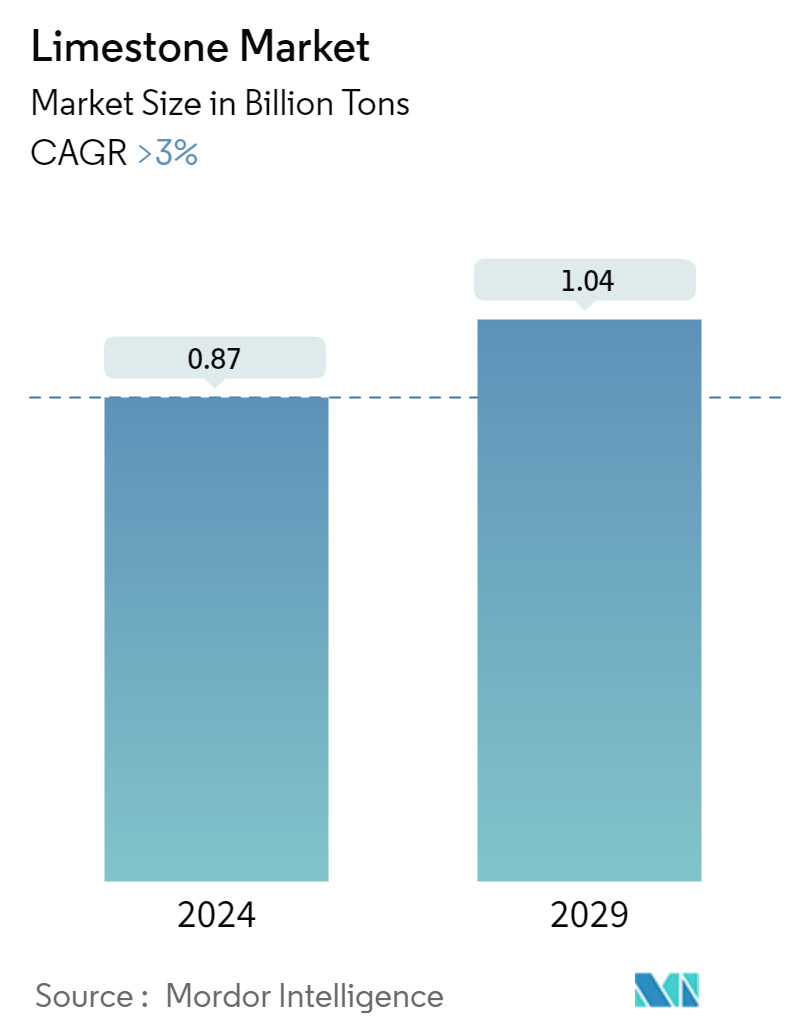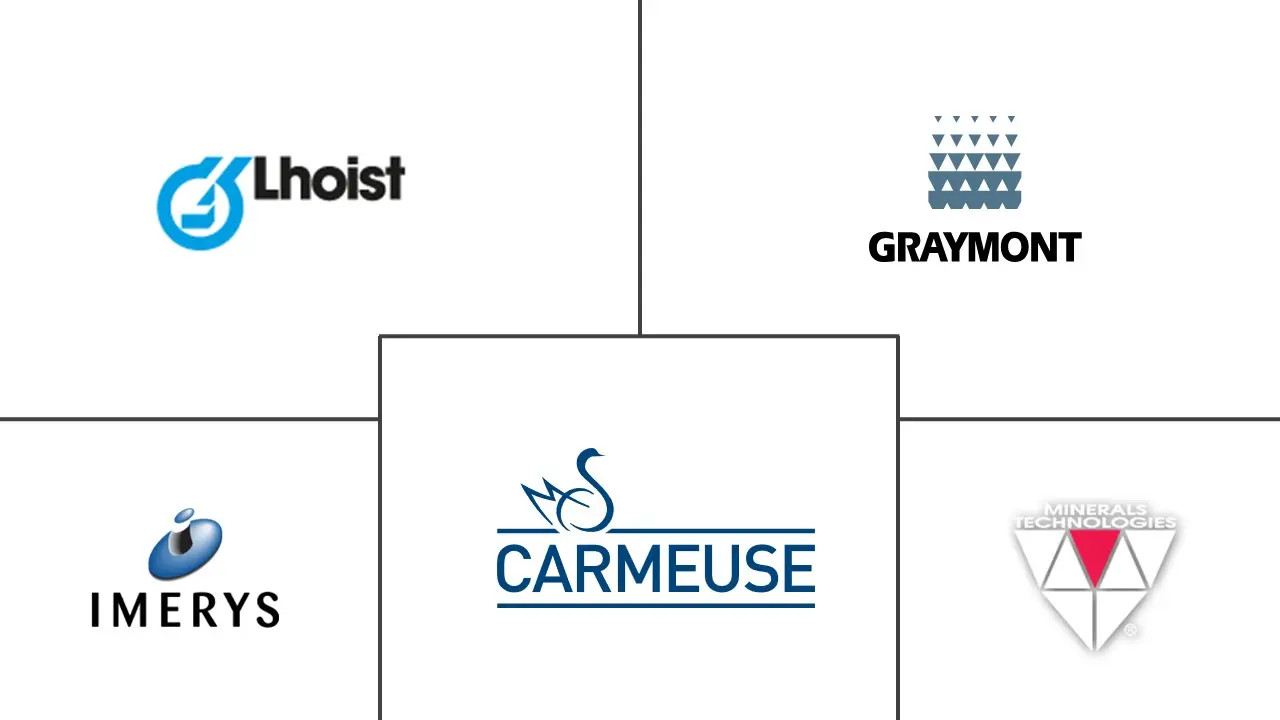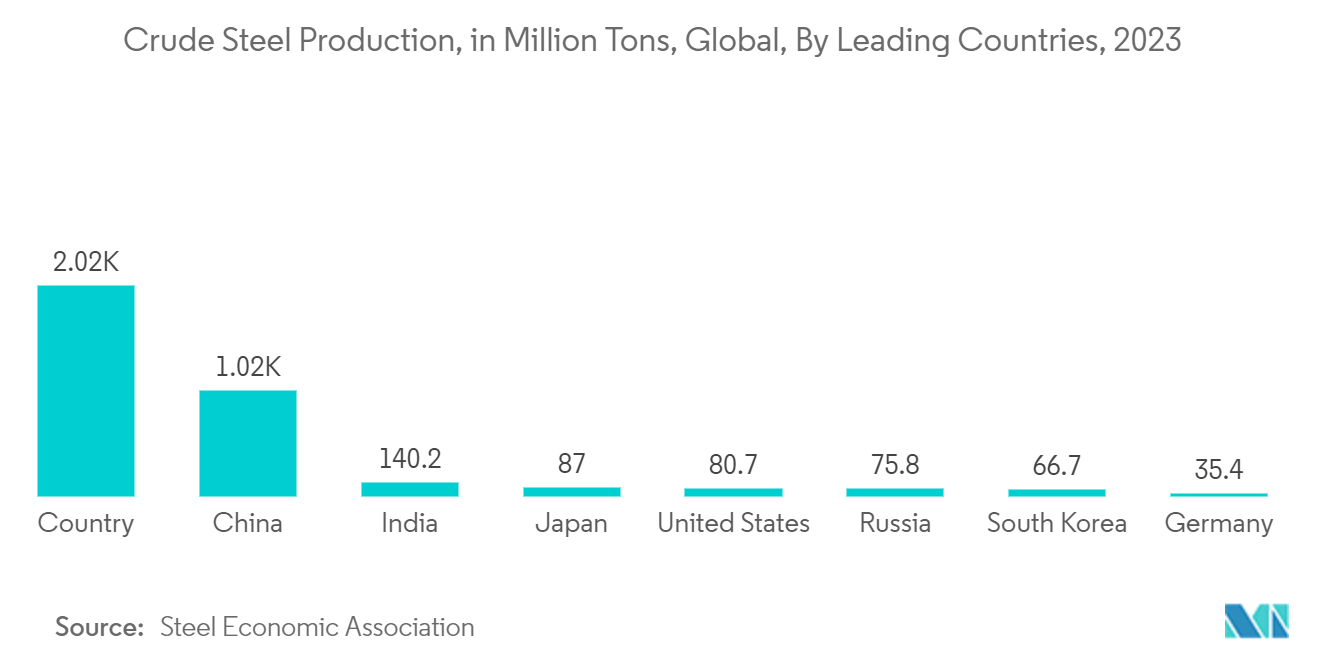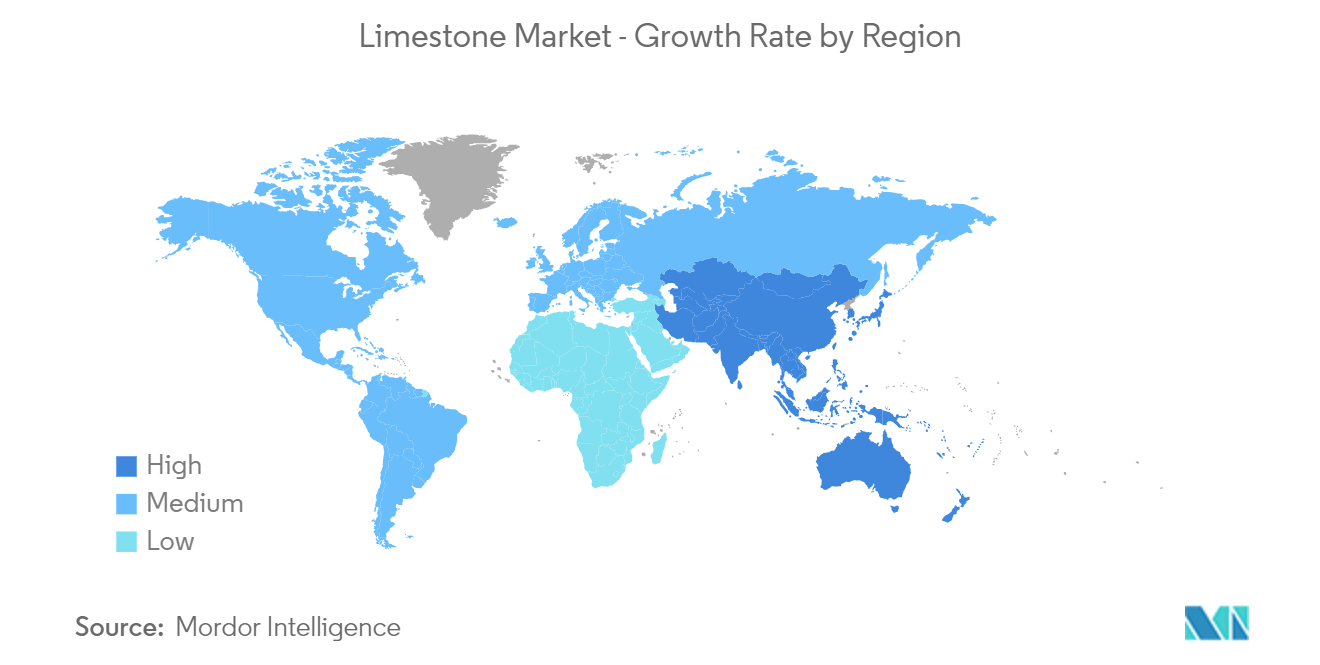Limestone Market Size

| Study Period | 2019 - 2029 |
| Base Year For Estimation | 2023 |
| CAGR (2024 - 2029) | 3.00 % |
| Fastest Growing Market | Asia Pacific |
| Largest Market | Asia Pacific |
| Market Concentration | High |
Major Players
*Disclaimer: Major Players sorted in no particular order |
Limestone Market Analysis
The Limestone Market size is estimated at 0.87 Billion tons in 2024, and is expected to reach 1.04 Billion tons by 2029, growing at a CAGR of greater than 3% during the forecast period (2024-2029).
The COVID-19 pandemic negatively impacted the market due to lockdowns in various countries worldwide, which resulted in disruptions in manufacturing activities and supply chains. However, the market has been recovering since restrictions were lifted, in line with rising demand from various end-user industries, such as paper and pulp, water treatment, agriculture, and construction.
• Over the short term, increasing demand from the construction industry and growing global steel production are some factors expected to drive market demand.
• On the flip side, the health risks associated with limestone consumption and the high carbon dioxide emissions from agricultural liming may hinder the market's growth.
• The upcoming global wastewater treatment projects are likely to create lucrative growth opportunities for the market in the coming years.
• The Asia-Pacific region is expected to dominate the market while also witnessing the highest CAGR during the forecast period.
Limestone Market Trends
Increasing Usage in Steel Manufacturing and Other Industries Driving Market Growth
- Limestone is used for the formation of slag in iron and steel manufacturing. Limestone, with low silica and alumina, is preferred for steel production, as these elements will need additional flux to neutralize them. Additional heat is required to keep the additional slag in a fluid state.
- To manufacture 1,000 kg of crude steel, the two key steel production routes using integrated steelmaking and the electric arc furnace require around 270 kg and 88 kg of limestone, respectively.
- Steel is the most critical alloy, with diversified applications in numerous industries, such as building and construction, automotive, electronics, and aerospace and defense.
- According to the World Steel Association, global steel production reached about 1,715.1 million tons from January to November of 2023, registering an increase of 0.5% compared to the previous year. Such developments are likely to increase the demand for limestone in the steel manufacturing industry.
- China is the largest producer of crude steel globally. However, according to the National Bureau of Statistics of China, crude steel production in China reached 67.44 million metric tons in December 2023, registering a decline in production compared to 76.1 million metric tons in November 2023. This decline in steel production was due to recent policy changes in China that sought to reduce steel output to tackle problems related to pollution levels.
- According to the American Iron and Steel Institute (AISI), US steel mills shipped 7,082,921 net tons of steel in December 2023, a 2.6% increase compared to 6,901,567 net tons in December 2022.
- Similarly, according to the Steel Economic Association of Germany, crude steel production in Germany reached 32.81 million tons in 2023; however, there was a decline in production compared with the production of 36.85 million tons in 2022.
- Furthermore, limestone is utilized in the production of iron as a fluxing agent, aiding in the removal of impurities, facilitating melting, and contributing to the efficiency of the blast furnace process.
- According to the Brazilian Institute of Geography and Statistics, the industry revenue of iron and steel foundries in Brazil reached USD 793.23 million in 2023. They maintained a similar value compared to USD 790.82 million in 2022.
- Therefore, in line with the above trends, the market is likely to be driven by the growing use of limestone in steel and iron industries over the next few years.

Asia-Pacific to Dominate the Market
- Asia-Pacific is expected to dominate the market over the coming years. In the regional market, China is the largest economy by GDP, while China and India are among the fastest-emerging economies worldwide. China dominates the limestone market in terms of consumption and production due to the local availability of raw materials and its huge chemical industry.
- The iron and steel industry consumes the most limestone globally and in China. China is a major crude steel producer globally, accounting for more than 50% of the global share. Europe, India, and Japan follow China.
- According to the National Bureau of Statistics (NBS), in China, the construction industry’s business activity index (BASI) rose to 56.9 as of December 2023 from 55.9 in November 2023. A BASI score above 50 indicates growth in the industry, and the October 2023 BASI score was 53.5, which suggested a strengthening of demand for the market studied.
- Similarly, China produced 13.59 million metric tons of processed paper and cardboard in December 2023, registering a growth of 12.9% compared to 12.03 million metric tons in December 2022.
- Due to the increase in urban population throughout China, 70% of the nation's population is expected to reside in cities by 2030. As the urban population increases, they also face an influx of wastewater and sludge. Currently, 80% of sludge in China is improperly dumped, an increasingly controversial environmental issue with urban centers scrambling to decrease pollution by improving their wastewater treatment plants (WWTPs).
- India’s paper industry accounts for about 5% of the world’s production of paper. According to OEA, the wholesale price index of paper and paper products across India reached 152 in the financial year 2023.
- India is the second-largest producer of steel globally. According to the Indian Steel Association, demand for steel in India was 119.9 million metric tons in 2023 and forecasted to reach 128.9 million metric tons in 2024.
- Limestone plays a pivotal role in the construction industry due to its fundamental use as a primary component for producing cement and concrete. When limestone is combined with other materials in the cement-making process, it undergoes a chemical transformation, contributing to the formation of durable and robust construction materials. The resulting concrete is widely employed in various construction projects, including buildings, bridges, roads, and other infrastructure, making limestone a crucial element in modern construction practices.
- India’s construction industry is projected to grow to USD 1.4 trillion by 2025. By 2030, an estimated 600 million people will live in urban centers, resulting in a need for 25 million additional mid- and ultra-luxury units. Under the National Investment Plan (NIP), India has an infrastructure investment budget of USD 1.4 trillion, with 24% earmarked for renewable energy, roads & highways, and urban infrastructure and 12% for railways.
- All the factors mentioned above are expected to boost the demand for limestone during the forecast period and, thereby, drive the market.

Limestone Industry Overview
The limestone market is partially consolidated in nature. Some of the major players in the market include (not in any particular order) Imerys, Carmeuse, Graymont Limited, Mineral Technologies Inc., and Omya International AG.
Limestone Market Leaders
-
Minerals Technologies Inc.
-
Imerys
-
CARMEUSE
-
Graymont Limited
-
Omya International AG
*Disclaimer: Major Players sorted in no particular order

Limestone Market News
- May 2023: Graymont announced the acquisition of GCCP Resources Ltd's Gridland limestone quarry located in Ipoh, Perak, to provide essential lime and limestone solutions to customers in essential industries across Malaysia. Through the acquisition, the company has strengthened its market presence in Malaysia.
- April 2022: Imerys announced new capacity expansion and optimization investments in the Sylacauga (AL) plant in Alabama, United States. Through the expansion, the company strengthened its market presence by supporting the growing demand for ground calcium carbonate products.
Limestone Market Report - Table of Contents
1. INTRODUCTION
- 1.1 Study Assumptions
- 1.2 Scope of the Study
2. RESEARCH METHODOLOGY
3. EXECUTIVE SUMMARY
4. MARKET DYNAMICS
-
4.1 Driver
- 4.1.1 Increasing Demand from the Construction Industry
- 4.1.2 Increasing Steel Production Globally
- 4.1.3 Other Drivers
-
4.2 Restraint
- 4.2.1 Health Risks Associated with Limestone
- 4.2.2 High Carbon Dioxide Emissions from Agricultural Liming
- 4.2.3 Other Restraints
- 4.3 Industry Value Chain Analysis
-
4.4 Porter's Five Forces Analysis
- 4.4.1 Bargaining Power of Suppliers
- 4.4.2 Bargaining Power of Consumers
- 4.4.3 Threat of New Entrants
- 4.4.4 Threat of Substitute Products and Services
- 4.4.5 Degree of Competition
- 4.5 Import-export Trends
- 4.6 Price Trends
5. MARKET SEGMENTATION (Market Size in Volume)
-
5.1 Application
- 5.1.1 Industry Lime
- 5.1.2 Chemical Lime
- 5.1.3 Construction Lime
- 5.1.4 Refractory Lime
-
5.2 End-user Industry
- 5.2.1 Paper and Pulp
- 5.2.2 Water Treatment
- 5.2.3 Agriculture
- 5.2.4 Plastics
- 5.2.5 Building and Construction
- 5.2.6 Steel Manufacturing and Other Industries
- 5.2.7 Other End-user Industries
-
5.3 Geography
- 5.3.1 Asia-Pacific
- 5.3.1.1 China
- 5.3.1.2 India
- 5.3.1.3 Japan
- 5.3.1.4 South Korea
- 5.3.1.5 Malaysia
- 5.3.1.6 Thailand
- 5.3.1.7 Indonesia
- 5.3.1.8 Vietnam
- 5.3.1.9 Rest of Asia-Pacific
- 5.3.2 North America
- 5.3.2.1 United States
- 5.3.2.2 Canada
- 5.3.2.3 Mexico
- 5.3.3 Europe
- 5.3.3.1 Germany
- 5.3.3.2 United Kingdom
- 5.3.3.3 France
- 5.3.3.4 Italy
- 5.3.3.5 Spain
- 5.3.3.6 Nordic Countries
- 5.3.3.7 Turkey
- 5.3.3.8 Russia
- 5.3.3.9 Rest of Europe
- 5.3.4 South America
- 5.3.4.1 Brazil
- 5.3.4.2 Argentina
- 5.3.4.3 Colombia
- 5.3.5 Middle East and Africa
- 5.3.5.1 Saudi Arabia
- 5.3.5.2 South Africa
- 5.3.5.3 Nigeria
- 5.3.5.4 Qatar
- 5.3.5.5 Egypt
- 5.3.5.6 United Arab Emirates
- 5.3.5.7 Rest of Middle East and Africa
6. COMPETITIVE LANDSCAPE
- 6.1 Mergers and Acquisitions, Joint Ventures, Collaborations, and Agreements
- 6.2 Market Ranking Analysis
- 6.3 Strategies Adopted by Leading Players
-
6.4 Company Profiles
- 6.4.1 AMR India Limited
- 6.4.2 CARMEUSE
- 6.4.3 GLC Minerals LLC
- 6.4.4 Graymont Limited
- 6.4.5 Gujarat Mineral Development Corporation Ltd
- 6.4.6 Imerys
- 6.4.7 Kerford Limestone
- 6.4.8 LafargeHolcim
- 6.4.9 Lhoist Group
- 6.4.10 Minerals Technologies Inc.
- 6.4.11 Okutama Kogyo Co. Ltd
- 6.4.12 Omya AG
- 6.4.13 RSMM Limited
- 6.4.14 Ryokolime Industry Co. Ltd (Mitsubishi Materials Corporation)
- 6.4.15 Schaefer Kalk
- 6.4.16 The National Lime & Stone Company
- 6.4.17 United States Lime & Minerals Inc.
- *List Not Exhaustive
7. MARKET OPPORTUNITIES AND FUTURE TRENDS
- 7.1 Upcoming Global Wastewater Treatment Projects
Limestone Industry Segmentation
Limestone is a sedimentary rock that is primarily composed of calcium carbonate, generally in the form of mineral calcite or aragonite. It is typically a biological sedimentary rock that is formed from the accumulation of shell, algal, fecal, coral, and other organic debris. However, some limestones are also formed by chemical sedimentary processes, including the precipitation of calcium carbonate from ocean or lake water.
The limestone market is segmented by application, end-user industry, and geography. By application, the market is segmented into industry lime, chemical lime, construction lime, and refractory lime. By end-user industry, the market is segmented into paper and pulp, water treatment, agriculture, plastics, building and construction, steel manufacturing, and other end-user industries (glass and mining, among others). The report also covers the sizes and forecasts for the limestone market in 27 countries across major regions. For each segment, the market sizing and forecasts have been done on the basis of volume (kilotons).
| Application | Industry Lime | |
| Chemical Lime | ||
| Construction Lime | ||
| Refractory Lime | ||
| End-user Industry | Paper and Pulp | |
| Water Treatment | ||
| Agriculture | ||
| Plastics | ||
| Building and Construction | ||
| Steel Manufacturing and Other Industries | ||
| Other End-user Industries | ||
| Geography | Asia-Pacific | China |
| India | ||
| Japan | ||
| South Korea | ||
| Malaysia | ||
| Thailand | ||
| Indonesia | ||
| Vietnam | ||
| Rest of Asia-Pacific | ||
| Geography | North America | United States |
| Canada | ||
| Mexico | ||
| Geography | Europe | Germany |
| United Kingdom | ||
| France | ||
| Italy | ||
| Spain | ||
| Nordic Countries | ||
| Turkey | ||
| Russia | ||
| Rest of Europe | ||
| Geography | South America | Brazil |
| Argentina | ||
| Colombia | ||
| Geography | Middle East and Africa | Saudi Arabia |
| South Africa | ||
| Nigeria | ||
| Qatar | ||
| Egypt | ||
| United Arab Emirates | ||
| Rest of Middle East and Africa |
Limestone Market Research FAQs
How big is the Limestone Market?
The Limestone Market size is expected to reach 0.87 billion tons in 2024 and grow at a CAGR of greater than 3% to reach 1.04 billion tons by 2029.
What is the current Limestone Market size?
In 2024, the Limestone Market size is expected to reach 0.87 billion tons.
Who are the key players in Limestone Market?
Minerals Technologies Inc., Imerys, CARMEUSE, Graymont Limited and Omya International AG are the major companies operating in the Limestone Market.
Which is the fastest growing region in Limestone Market?
Asia Pacific is estimated to grow at the highest CAGR over the forecast period (2024-2029).
Which region has the biggest share in Limestone Market?
In 2024, the Asia Pacific accounts for the largest market share in Limestone Market.
What years does this Limestone Market cover, and what was the market size in 2023?
In 2023, the Limestone Market size was estimated at 0.84 billion tons. The report covers the Limestone Market historical market size for years: 2019, 2020, 2021, 2022 and 2023. The report also forecasts the Limestone Market size for years: 2024, 2025, 2026, 2027, 2028 and 2029.
Limestone Industry Report
Statistics for the 2024 Limestone market share, size and revenue growth rate, created by Mordor Intelligence™ Industry Reports. Limestone analysis includes a market forecast outlook to 2029 and historical overview. Get a sample of this industry analysis as a free report PDF download.



